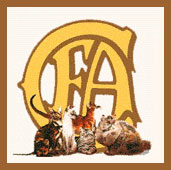|
On 6.12.2001 a meeting
of judges, breeders and other representatives of cat fanciers took place in
Moscow. The meeting was called on the initiative of the International Committee
of Cat Judges. Among those
present (35 people) were:
Mrs. Olga
Abramova, WCF Int.Judge |
Mrs. Inna
Shustrova, WCF Int.Judge |
Mrs. Larisa
Ovchinnikova, WCF Int.Judge |
Mrs. Olga
Mironova, SFF judge |
Mr. Alexey
Stchukin, TICA/WCF judge |
Mr. Vladimir
Nechaev, chief editor of "Drug", Russian cat fancy magazine |
Mrs. Tatiana
Pavlova, Union of Siberian Cat Fanciers. |
|
Breeders
representing the following catteries: |
Veschiy Son, Losinyi Ostrov, White Night,
de Gleimur, Adagio, Zhemchug Nevy. Representatives of cat fanciers clubs from
Moscow, Omsk and Tomsk. |
The questions
discussed were the origin and development of aboriginal Russian cat breeds, the
type and breeding of Siberian cats including Neva Masquerade. The reason for the
meeting were the efforts of some breeders and judges to separate the colourpoint
from the Siberian breed.As a result of the
heated discussion the following resolution was carried:
1. All the
breed-forming features of the Nevas are equal to those of Siberians. That's why
it is considered to be pointless to register the Nevas as a new breed. Neva
Masquerades are Siberian colourpoints, and as such, they are bred together with
other colours of Siberian cats and shown as Siberian cats according to the show
rules divided in groups according to sex, age and colour). It is desirable and
sensible to cross Siberians and Nevas |
2. One should
gradually try to set limits to using non-pedigree Siberian phenotype cats,
including colourpoints. A total banning of novice cats is not reasonable on the
recent stage of breed development. The novice class should be open for them for
at least 5 years. |
3. The judges are
recommended to be stricter to all signs of Persian or Balinese outcrossing in
all colours of Siberian cats in order to exclude such cats from breeding. |
4. The correct type is
considered to be the main feature. The coat should correspond to the standard in
every colour, but one should take into consideration that agouti cats always
have the most characteristic coat. |
5. A darkened body,
tabby markings or spots on the flanks and belly are not a reason for penalizing,
as it is characteristic of aboriginal cats that presumably had in their history
crosses with wild cats. Moreover, aboriginal Russian cats still often have
access to outdoors in summer. |
6. Breeders and judges
should consider if it is necessary to distinguish between different types of
tabby in Nevas, as in colourpoints tabby patterns are blurred and indistinct,
and the cat can be penalized for lack of clarity in the pattern. |
7. The contrast
between the points and the body stays a requirement of the standard. |
|
